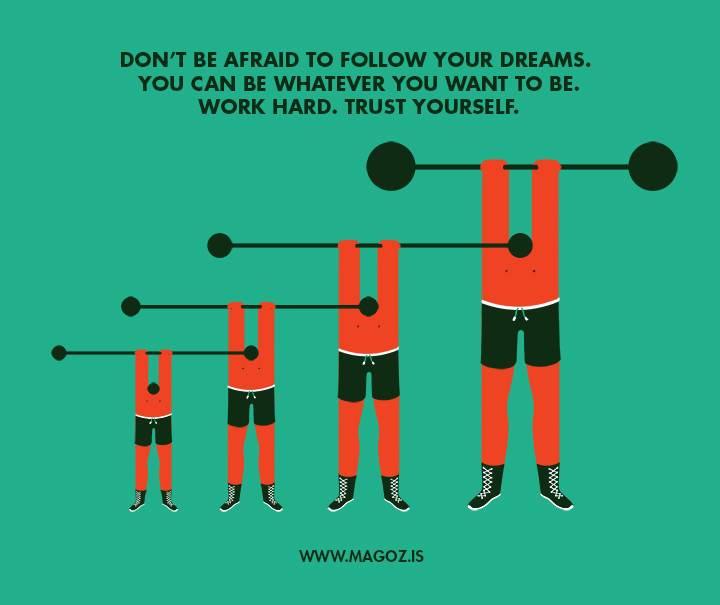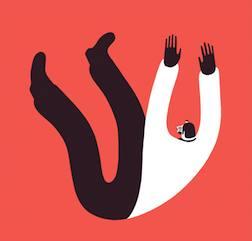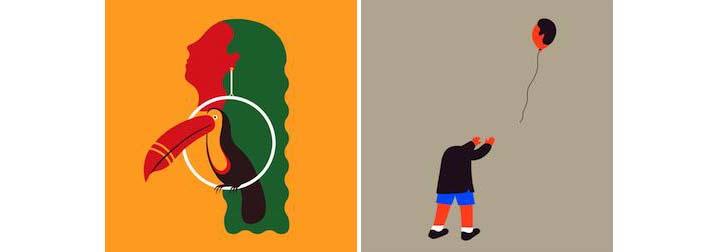The Q&A: Magoz
Q: Originally from Barcelona what are some of your favorite things about living and working traveling around?
A: I decided to leave Barcelona because I realized I was able to work from anywhere. This discovery was mind-blowing for me. Suddenly I was able to move wherever and see the world, so I did.
I moved to Bristol, then to Finland and now I’m moving to Malaysia at the end of the year. This is the most amazing thing for me, being a free person able to go and do whatever he wants. But I’m also extremely happy about the fact of being able to invest all my time in myself, especially developing artwork and working with ideas and creativity.
Q: Do you keep a sketchbook? What is the balance between the art you create on paper versus In the computer?
A: I use the sketchbook as the first stage of hunting ideas. It’s the most useful tool to generate ideas, so when I capture them I leave the pencil and the sketchbook and I start working on my computer. So I would say that paper is the perfect tool for generating/capturing ideas, the computer is the perfect tool to bring them to life and make them real.
Q: What do you like best about your workspace?
A: I don’t have a proper/fixed workspace because of my nomad situation. This and other facts make my way of living very minimalistic, which at the same time helps me to focus on the important things.
Q: Do you think it needs improvement, if so, what would you change?
A: Light and the calm are the two most important things while I work, so these are the things I’m trying to improve all the time.

Q: What is the most important item in your studio?
A: The only items I have in my studio are my sketchbook, a pencil, an eraser, my mac and my Cintiq tablet (and obviously a table and a chair). Each of them are completely necessary. Working with nothing but the essential tools makes me closer to the essence and away from distractions.
Q: What is your favorite part of the creative process?
A: Without any doubt it’s when I get the idea I was looking for, the Eureka moment.
As when you get a joke, when you solve a riddle or an enigma. It makes you feel very realized and excited, everything at the same time.
Q: What was the strangest or most unusual assignment you’ve taken? What made it a success or a failure?
A: To illustrate a letter from a man to his prostate. It was hilarious and a bit uncomfortable but at the same time it was a new opportunity to challenge myself. And in the end everything ended well.
Q: What was your favorite book as a child?
A: I can’t remember the name or what it was about, but probably was the first book I've ever seen. It was a book for babies, a board book, with very thick pages. I remember some illustrations: a moon, a car, a tree. Probably this was my favorite book because I spent a lot of time looking at the pages over and over again.
 Q: What is the best book you’ve recently read?
Q: What is the best book you’ve recently read?
A: Siddhartha by Hermann Hesse. I’ve read it several times in different moments of my life and I always found very inspiring and helpful thoughts inside.
Q: Do you remember the first time you made an abstracted illustration, and what prompted you to leave realism behind?
A: Probably was when I was a child I started drawing in an abstract way. Then I gradually began to draw more and more realistically. And when I discovered what illustration was, I completely rejected the realism in order to find my way of illustrating, let’s say in a figurative but not abstract way. So I never illustrated in a completely abstract way.
I love the figurative way of illustration because it has the perfect balance between the property of identifying things (realism) and a huge space for the magic where everything is possible (abstraction).
Q: What was your first professional assignment and how did you get it? Was it a success or a failure?
A: It was for Scientific American, one day after Anna Goodson started representing me internationally (three years ago). It was a success, but I worked on the idea almost a whole week before sending the sketch, I was very nervous.
Q: What did you learn from the experience?
A: That illustrating is the most amazing job/activity you can spend your life in.
Q: What are some of your favorite places/books/blogs/websites for inspiration?
A:
- My own library built in Evernote.
- My sketchbook.
- Nature (specially forests).
Q: What advice would you give a young artist about applying to an art school or college?
A: I didn’t learn many useful things at school. I learned almost everything I know developing personal projects after the school (mainly through two digital magazines I created and developed with some colleagues over a period of three years).
I would advise young artists to go to the best schools they can, but at the same I would say that the schools are not the only way of learning and they are not going to receive a magic formula there. In my opinion, nowadays exists a massive gap between the education and the professional world, where no one can tell you what you need to do. It’s a very important and difficult moment that defines who you are going to be. I like to call it "the journey through the desert", you never know where or when you are going finish this stage, or even if you are going to survive. The most important for me is to be very active, patient, develop personal projects, and be in touch with the illustration world as much as possible.

Q: If you could be anywhere but where you are now, where would that be?
A: That place would be where were possible to travel in time, to travel and meet some of the greatest people in human history that have profoundly influenced me.
Q: What would be your last supper?
A: A good riddle.
Magoz is a nomad illustrator. Originally from Barcelona, he is currently traveling around the world. He develops editorial illustrations for clients including The New York Times, The Wall Street Journal andScientific American, in addition to working in personal projects. Through a poetic language, he conceives his own way of expression focusing on the conceptual value of the images. Always aiming for minimalism and simplicity, Magoz works only with few elements using few colours, without strokes, gradients or ornaments but full of meaning in order to communicate effectively.


